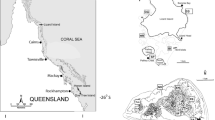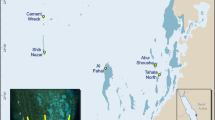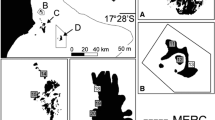Summary
Size-specific mortality rates and growth rates for the solitary coral Balanophyllia elegans are determined from size—frequency distributions of live corals from natural and artificial substrates, and from skeletons of dead corals found in rubble channels. Marked quadrats were monitored to measure actual recruitment and mortality for juveniles and adults. First year rate of mortality for juveniles is high, 56%; and mortality rate for adults is about 10% annually. Estimates of annual larval survivorship (44%) are incorporated in a life table, and other demographic parameters are calculated. B. elegans has a high intrinsic rate of increase apparently because of high larval survivorship and early onset of reproduction. Population growth is checked partly by high juvenile and random adult mortality. I estimate a 6–11 year average life span for B. elegans at the Hopkins Marine Life Refuge in Pacific Grove, California.
Similar content being viewed by others
References
Ayal Y, Safriel UN (1982) r-Curves and the cost of the planktonic stage. Am Nat 119(3): 391–401
Bak RPM, Engel MS (1979) Distribution, abundance and survival of juvenile hermatypic corals (Scleractinia) and the importance of life-history strategies in the parent coral community. Mar Biol 54:341–352
Connell JH (1970) A predator-prey system in the marine intertidal region. I. Balanus glandula and several predatory species of Thais Ecol Monogr 40(1):49–78
Connell JH (1973) Population ecology of reef corals. In: Jones OA, Endean R (eds) Biology and Geology of Coral Reefs. Vol. 2, Biol 1: 205–245 Academic Press, New York
Durham JW (1947) Corals from the Gulf of California and the North Pacific Coast of America. Geol Soc Amer Mem 20: 68 pp
Durham JW (1949) Ontogenetic stages of some simple corals Univ Calif Publ/Bull Dept Geol Sci 28(6): 137–172
Durham JW, Barnard JL (1952) Stony corals of the Eastern Pacific collected by the Velero III and Velero IV. Allan Hancock Pacific Expeditions 16(1):1–110
Fabens AJ (1965) Properties and fitting of the von Bertalanffy growth curve. Growth 29:205–289
Fadlallah YH (1981) The reproductive biology of three species of corals from central California. 193 pp. Ph D Thesis. University of California, Santa Cruz
Fadlallah YH, Pearse JS (1982) Sexual reproduction in solitary corals: Overlapping oogenic and brooding cycles, and benthic planulas in Balanophyllia elegans. Mar Biol 71:223–231
Garrison DL (1979) Monterey Bay phytoplankton. I. Seasonal cycles of phytoplankton assemblages. J Plankton Res 1(3):241–265
Gerrodette T (1979a) Ecological studies of two temperate solitary corals. PhD Thesis. Scripps Institution of Oceanography, University of California, San Diego
Gerrodette T (1979b) Equatorial submergence in a solitary coral, Balanophyllia elegans, and the critical life stage excluding the species from shallow water in the south. Mar Ecol Prog Ser 1:227–235
Gerrodette T (1981) Dispersal of the solitary coral Balanophyllia elegans by demersal planulae larvae. Ecology 62(3):611–619
Goreau NI, Goreau TJ, Hayes RL (1981) Setting, survivorship and spatial aggregation in planulae and juveniles of the coral Porites porites (Pallas). Bull Mar Sci 31(2):424–435
Grigg RW (1977) Population dynamics of two gorgonian corals. Ecology 58:278–290
Hines AM (1981) Coexistence in a kelp forest: size, population dynamics, and resource partitioning in a guild of spider crabs (Brachyura, Majidae). Ecol Monogr 52(2):179–198
Jackson GA, Strathmann RR (1981) Larval mortality from offshore mixing as a link between precompetent and competent period of development. Am Nat 118(1):16–25
Kaufmann KW (1981) Fitting and using growth curves. Oecologia (Berlin). 49:293–299
Krebs CJ (1978) Ecology:The experimental analysis of distribution and abundance. 2nd edn Harper and Row, New York
Lessios HA (1981) Reproductive periodicity of the echinoids Diadema and Echinometra on the two coasts of Panama. J Exp Mar Biol Ecol 50:47–61
Loya Y (1976) The Red Sea coral Stylophora pistillata is an r-strategist. Nature 259:478–480
Mertz DB (1970) Notes on methods used in life-history studies. In: Connell JH, Mertz DB, Murdoch WW (eds) Readings in Ecology and Ecological genetics. Harper and Row, pp 4–17
Michod RE (1979) Evolution of life histories in response to agespecific mortality factors. Am Nat 113:531–550
Mines AM (1979) The comparative reproductive ecology of three species of intertidal barnacles. In: SE Stancyk (ed) Reproductive ecology of marine invertebrates, vol. 9 pp 213–234. Belle W. Baruch Library in marine Science. Columbia: University of South Carolina Press
Murphy GI (1968) Pattern in life history and the environment. Am Nat 102:391–403
Pears JS, Lowry LF (1974) An annotated species list of the benthic algae and invertebrates in the kelp forest community at Point Cabrillo, Pacific Grove, California. Coastal Mar Lab, University of California Tech Rep 1:73 pp
Pearse JS Pearse VB (1975) Growth zones in the echinoid skeleton. Am Zool 15:731–735
Schaffer WM (1974) Optimal reproductive effort in fluctuating environments. Am Nat 108:783–790
Schuhmacher H (1974) The conditions accompanying the first settlement of corals on artificial reefs with special reference to the influence of grazing urchins (Eilat, Red Sea). Proc 2nd Int. Coral Reef Symp 1:257–267
Stearns SC (1976) Life history tactics: a review of the ideas. Q Rev Biol 51:3–47
Stearns SC (1977) The evolution of life history traits: a critique of the theory and a review of the data. Ann Rev Ecol Syst 8:145–147
Strathmann RR, Strathmann MF (1982) The relationship between adult size and brooding in marine invertebrates. Am Nat 119:91–101
Thorson G (1950) Reproductive and larval ecology of marine invertebrates. Biol Rev 39:1–42
Weaver AM (1977) Aspects of the effects of particulate matter on the ecology of a kelp forest (Macrocystis pyrifera (L) C.A. Agardh) near a small domestic sewer oufall. Ph D Diss Stanford University
Author information
Authors and Affiliations
Rights and permissions
About this article
Cite this article
Fadlallah, Y.H. Population dynamics and life history of a solitary coral, Balanophyllia elegans, from Central California. Oecologia 58, 200–207 (1983). https://doi.org/10.1007/BF00399217
Received:
Issue Date:
DOI: https://doi.org/10.1007/BF00399217




